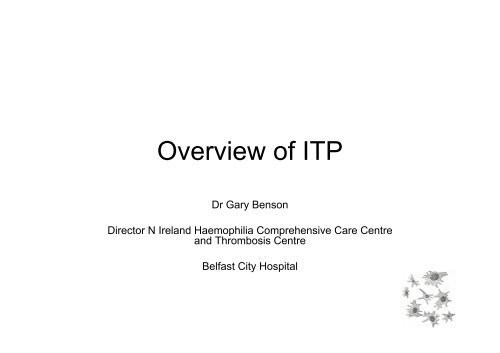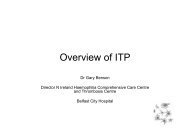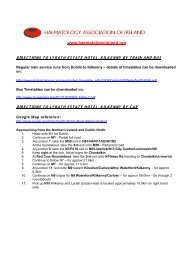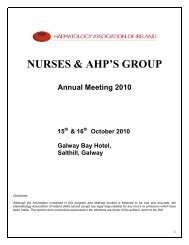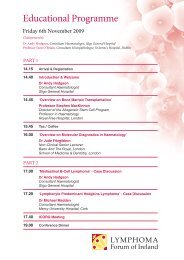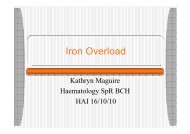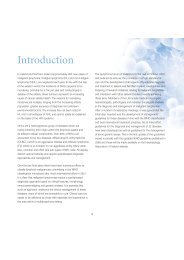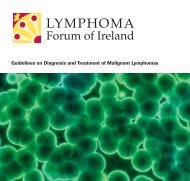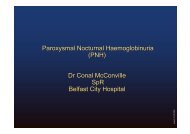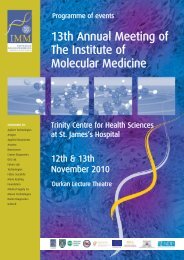Overview of ITP - Haematology Association of Ireland
Overview of ITP - Haematology Association of Ireland
Overview of ITP - Haematology Association of Ireland
Create successful ePaper yourself
Turn your PDF publications into a flip-book with our unique Google optimized e-Paper software.
<strong>Overview</strong> <strong>of</strong> <strong>ITP</strong><br />
Dr Gary Benson<br />
Director N <strong>Ireland</strong> Haemophilia Comprehensive Care Centre<br />
and Thrombosis Centre<br />
Belfast City Hospital
Idiopathic (Immune)<br />
Thrombocytopenic Purpura<br />
• Thrombocytopenia in the absence <strong>of</strong> other<br />
blood cell abnormalities (normal RBC &<br />
WBC, normal blood film)<br />
• No clinically apparent conditions or<br />
medications that can account for<br />
thrombocytopenia
Statistics <strong>of</strong> <strong>ITP</strong><br />
• Incidence <strong>of</strong> 22 /million/year in one study<br />
• Prevalence greater as <strong>of</strong>ten chronic<br />
*Segal et al �100 /million/year<br />
*age-adjusted prevalence 9.5/100,000<br />
*1.9 :1 females / males
Clinical Manifestations<br />
• May be acute or insidious onset<br />
• Mucocutaneous Bleeding<br />
*petechiae, purpura, ecchymosis<br />
*epistaxis, gum bleeding<br />
*menorrhagia<br />
*GI bleed, CNS bleed = RARE
Aetiology <strong>of</strong> <strong>ITP</strong> : Children<br />
• Maternal associated<br />
• Often after infection (viral or bacterial)<br />
– Post MMR vaccination<br />
• Theories:<br />
*antibody cross-reactivity<br />
*H. pylori<br />
*bacterial lipopolysaccharides
Aetiology <strong>of</strong> <strong>ITP</strong> : Adults<br />
• ?? Auto-antibodies?
Diagnosis (<strong>of</strong> Exclusion)<br />
• Rule out other causes:<br />
*lab error / PLT clumping<br />
*drug / medication interaction<br />
*infections (HIV, Hepatitis C)<br />
*thyroid / autoimmune disease<br />
*destructive / consumptive processes (TTP/HUS)<br />
*bone marrow disease (leukemias, MDS)
Diagnosis (<strong>of</strong> Exclusion)<br />
• Rule out other causes:<br />
*lab error / PLT clumping<br />
*drug / medication interaction<br />
*infections (HIV, Hepatitis C)<br />
*thyroid / autoimmune disease<br />
*destructive / consumptive processes (TTP/HUS)<br />
*bone marrow disease (leukemias, MDS)
To Marrow or Not to Marrow?<br />
• Bone marrow aspiration & biopsy if…<br />
• Patient 60 yrs. or older<br />
• Poorly responsive to tx<br />
• Unclear clinical picture
Anti-Platelet Antibody Testing<br />
• NOT recommended by BSH Practice<br />
Guidelines<br />
• Poor positive/negative predictive values,<br />
poor sensitivity with all current testing<br />
methods…<br />
• …and doesn’t change the management!
Management <strong>of</strong> <strong>ITP</strong> in Adults<br />
• Emergency vs. Chronic Tx<br />
• Goal = prevention <strong>of</strong> bleeding, NOT cure!
Management <strong>of</strong> <strong>ITP</strong> in Adults<br />
• Emergency vs. Chronic Tx<br />
• Goal = prevention <strong>of</strong> bleeding, NOT cure!
General Principles <strong>of</strong> Therapy<br />
• Major bleeding rare if PLT > 10,000<br />
• Goal = get PLT count to safe level to<br />
prevent bleeding…<br />
•…not to specifically cure the <strong>ITP</strong>!
“Safe” Platelet Counts<br />
• “moderately” t-penic = 30-50,000<br />
• Probably safe if asymptomatic<br />
• Caution with elderly (CNS bleeds)
When Planning Therapy…<br />
• Tailor therapy and decision to treat to the<br />
individual patient<br />
• Weigh bleeding vs. therapy risks
Initial Therapy<br />
• Prednisolone 1 mg/kg/day<br />
*usual response within 2 weeks<br />
• Taper <strong>of</strong>f after PLT response<br />
• Duration <strong>of</strong> use = controversial
Second-Line Therapy<br />
• IV Immune Globulin (IVIg)<br />
1 gram/kg/day x 2 days<br />
• anti-D – if pt is Rh+<br />
50-75 mcg/kg/day
Treatment Side-Effects<br />
•Steroids<br />
*bone density loss *GI effects<br />
*muscle weakness *weight gain<br />
• IVIG/anti-D<br />
*hypersensitivity *headache<br />
*renal failure *nausea/vomiting<br />
*alloimmune haemolysis
Splenectomy<br />
• Usually reserved for treatment failure<br />
• Consider risk <strong>of</strong> bleeding, pt lifestyle<br />
• RISKS<br />
*surgical procedure<br />
*loss <strong>of</strong> immune function � vaccinations
Response Post-Splenectomy<br />
• Usually normalized PLTs within 2 weeks<br />
(<strong>of</strong>ten immediately)<br />
• Younger pts do better<br />
• Kojouri et al (Blood 2004) � 65% CR
Data from Fabris, F, et al. Br J Haematol 2001; 112:637.
Chronic Refractory <strong>ITP</strong><br />
• Persistent > 3 months<br />
• PLT < 50,000<br />
• Failure to respond to splenectomy
When all else fails…<br />
• Steroids<br />
• IVIg / anti-D<br />
• Rituximab (anti-CD20)<br />
• Cyclophosphamide<br />
• Danazol<br />
• Accessory splenectomy<br />
• H. pylori eradication
Mean SF-36 Scores<br />
<strong>ITP</strong> and Health-Related QOL<br />
SF-36 Domains and Component Summary Scales<br />
• Patients with <strong>ITP</strong> have worse QOL than the general<br />
population and patients with common disorders<br />
• <strong>ITP</strong> QOL is better than CHF or missing or paralyzed limb<br />
McMillan R, et al. Am J Hematol. 2008;83(2):150-154.
Pathophysiology <strong>of</strong> <strong>ITP</strong><br />
AP<br />
O<br />
TC<br />
Cines DB, Blanchette VS. N Engl J Med. 2002;346:995-1008.<br />
P<br />
D<br />
AP Autoantibody<br />
Production<br />
O<br />
D<br />
P<br />
TC<br />
Platelet<br />
Opsonization<br />
Platelet<br />
Destruction<br />
Platelet<br />
Production<br />
T-Cell–Mediated<br />
Cytotoxicity
Mechanism-Based Approaches to<br />
Treatment<br />
• Inhibit phagocyte-mediated clearance <strong>of</strong> Ab-coated platelets<br />
– Steroids<br />
– Splenectomy<br />
– Anti-D<br />
– IVIG<br />
• Decrease antibody production<br />
– Rituximab<br />
– Steroids<br />
– Azathioprine and other immunosuppressants (eg, cyclophosphamide,<br />
cyclosporine, mycophenolate m<strong>of</strong>etil)<br />
• Impair T and B cell interactions<br />
– Steroids<br />
– Rituximab<br />
– Other immunosuppressants<br />
• Enhance platelet production<br />
– Thrombopoietic agents<br />
– Interleukin 11
Platelet Count (x 10 3 /µl)<br />
Thrombopoietin Levels in <strong>ITP</strong><br />
250<br />
200<br />
150<br />
100<br />
50<br />
0<br />
Healthy<br />
Donors<br />
Mukai HY, et al. Thromb Haemost. 1996;76:675-678.<br />
<strong>ITP</strong> AMT*<br />
*Amegakaryocytic thrombocytopenia<br />
25<br />
20<br />
15<br />
10<br />
5<br />
0<br />
Serum TPO (fmoles/ml)
Romiplostim Trials – Platelet Count<br />
Kuter DJ, et al. Lancet. 2008;371:395-403.
Durable Responses in Romiplostim<br />
Durable Platelet Response (%)<br />
80<br />
70<br />
60<br />
50<br />
40<br />
30<br />
20<br />
10<br />
0<br />
0.0<br />
38.1<br />
Splenectomized<br />
(P = 0.0013)<br />
Trials<br />
Durable Response: Weekly platelet count ≥ 50,000 on 6<br />
<strong>of</strong> last 8 weeks <strong>of</strong> study; no rescue meds allowed<br />
Kuter DJ, et al. Lancet. 2008;371:395-403.<br />
4.8<br />
61.0<br />
Nonsplenectomized<br />
(P = 0.0001)<br />
2.4<br />
49.4<br />
Total<br />
(P = 0.0001)<br />
Placebo<br />
AMG-531
Mean (SE) Platelet<br />
Count x 109 /L<br />
Mean (SD) Dose (µg/kg)<br />
300<br />
250<br />
200<br />
150<br />
100<br />
50<br />
0<br />
10<br />
8<br />
6<br />
4<br />
2<br />
0<br />
Mean Platelet Count and<br />
Romiplostim<br />
Dose Over 204 Weeks<br />
Study Week<br />
1 4 8 16 24 32 40 48 56 64 72 80 88 96 104 112 120 128 136 144 152 160 168 176 184 192 200<br />
n = 212 183 160 146 136 123 118 112 108 103 99 96 86 70 62 58 48 34 26 21 22 21 17 14 12 6<br />
n is the number <strong>of</strong> patients with available platelet counts, excluding those who received rescue<br />
medications. Platelet counts within 8 weeks after receiving any rescue medications were<br />
excluded.<br />
Kuter DJ, et al. Blood. 2008;112:Abstract 402.
Median Platelet Count (x1,000/µL)<br />
Eltrombopag and Median Platelet<br />
Cheng G, et al. Blood. 2008;112:Abstract 400.<br />
Counts:<br />
RAISE<br />
• Phase III clinical trial<br />
• 26 weeks plus observation
Eltrombopag Enhances Platelet Count<br />
and Ability to Initiate Interferon Therapy<br />
Patients With ≥ 100,000<br />
Platelets /µL at 4 Weeks<br />
P ≤ 0.001 for each group vs Pbo<br />
McHutchison J, et al. N Engl J Med. 2007;357:2227-2236.<br />
Patients Entering Antiviral Phase
Emergency Treatment <strong>of</strong> Adult <strong>ITP</strong><br />
• IVIG (1.0 g/kg/d for 2–3 days) and/or<br />
• Methylprednisolone (1.0 g/d x 3d)<br />
• ± Platelet transfusion<br />
•±Factor VIIa<br />
Cines DB, McMillan R. Annu Rev Med. 2005;56:425-442.
Initial Treatment <strong>of</strong> Adult <strong>ITP</strong><br />
Platelet count: > 25–30,000/µl<br />
• No treatment<br />
Platelet count: < 25–30,000/µl<br />
• Immunization<br />
• Splenectomy<br />
• Rituximab<br />
• TPO agonist<br />
Platelet count: < 25–30,000/µl<br />
Adapted from Cines DB, McMillan R. Annu Rev Med. 2005;56:425-442.<br />
• Prednisolone (1 mg/kg/d PO) or<br />
• Periodic Anti-D (50–75 µg/kg IV as needed) or<br />
• Dexamethasone (40 mg/day x 4 days/month)<br />
Stable platelet count > 25–30,000/µl<br />
• No therapy
Treatment <strong>of</strong> Patients Failing<br />
Platelet count: < 25–30,000/µl<br />
First-line Therapy<br />
• Rituximab<br />
• TPO agonist<br />
• Prednisone<br />
• Danazol/pred<br />
Splenectomy<br />
Second-line Therapy<br />
• Azathioprine<br />
•Oral<br />
cyclophosphamide<br />
• Mycophenolate<br />
m<strong>of</strong>etil<br />
• Cyclosporine<br />
Adapted from Cines DB, McMillan R. Annu Rev Med. 2005;56:425-442.<br />
Third-line Therapy<br />
• High-dose<br />
cyclophosphamide<br />
• Combination<br />
chemotherapy<br />
• Stem-cell transplantation
Wrapping it up…<br />
• <strong>ITP</strong> is <strong>of</strong>ten a chronic disease in adults<br />
• Multiple therapies may be needed over<br />
time<br />
• Goal = prevention <strong>of</strong> complications<br />
• Therapy needs to be tailored to the<br />
individual patient


